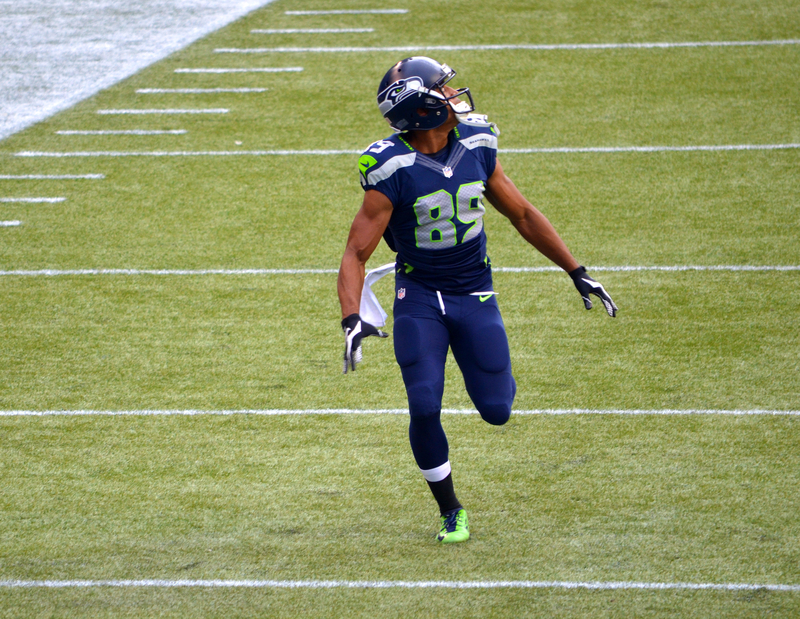Last updated on November 3rd, 2023 at 08:23 am
There are two types of players on the offensive team in American football, eligible receivers, and ineligible receivers. Ineligible receivers are players who cannot be the target of a forward pass in football.
What Is The Difference Between Ineligible and Eligible Receivers in Football?
When a team on offense sets up at the line of scrimmage, they have several players who are “eligible” and “ineligible” receivers. Most people recognize wide receivers and tight ends as eligible receivers, while ineligible receivers are centers, offensive tackles, and offensive linemen.
What makes an offensive player an ineligible receiver is that they cannot be the target for a forward pass. That’s not to say ineligible receivers can’t contribute to a game. Football rules stipulate that ineligible receivers can pass or run the ball. Similarly, they can catch a lateral or backward pass. They can even catch a blocked or tipped pass caused by a defensive linebacker on the other team, which can then fall into their hands.
How Do Football Teams Know Which Receivers are Ineligible or Eligible?
There are a few ways that defensive players can identify an offensive player’s eligibility. First, they can look to see how these players line up on the field. Eligible receivers are at the end of the scrimmage line, where you’ll usually see wide receivers or tight ends. They can also be at least one yard behind the line of scrimmage, which is the case for running backs and fullbacks.
Defensive players can also look at the numbers on each player’s jersey. Players with jersey numbers between 50 and 79 are usually linemen and therefore are ineligible receivers. These players can become eligible if they check in as “eligible” with the officiating team before the play. At that point, a referee will announce to inform the teams which receivers are eligible. After checking in, they can line up one yard behind the scrimmage like a standard wide receiver.
The NFL rules dictate that eligible receivers can become ineligible if they run out of bounds at any time during the play. The only exception is if someone pushed them out of bounds because of a defensive foul like pass interference or holding. If this is the case, the player can become eligible once more if they place both feet in bounds.
Finally, players that line up under-center in the back of a T-formation are ineligible receivers unless they line up at the line of scrimmage and are stationary for at least one second before the snap of the ball. This formation occurs in wildcat or quarterback option plays, where the passer slots in as an eligible receiver.
Strategic Use of Ineligible Receivers
The New England Patriots came under fire during the 2014- 2015 season for creatively using ineligible receivers to surprise or confuse opposing defenses. The play often involved declaring a high-value target ineligible but lining them up in a position that would typically host an eligible receiver. For example, putting a running back at the end of the line of scrimmage can cause this confusion to the defense.
Since the receiver would be wearing the number of a receiver or running back, it would be hard for defenses to recognize them as ineligible players. This strange formation often caused them to block that player inadvertently, leaving other positions open for a potential touchdown pass to an eligible receiver. More often than not, this tactic was successful, ending with a clear shot at the end zone and a touchdown for New England.
This tactic got much attention ahead of Super Bowl 49 between the Patriots and the Seattle Seahawks. At the start of the next season, the league amended the ineligible receiver rule, stating that all ineligible receivers with numbers between 1-49 and 80-89 must line up in the tackle box to avoid confusion.
What is an Ineligible Receiver Downfield Penalty?
If the quarterback throws a pass while an ineligible receiver is past the line of scrimmage, it can result in a penalty. The ruling for this penalty is different in the NCAA and the NFL, however. The NCAA rule states that ineligible receivers can go three yards past the neutral zone without incurring a penalty.
In the NFL, an ineligible man can’t be more than one yard past the line of scrimmage unless they started blocking a defensive player and continue to block them downfield. In both professional and college football, the QB throwing the ball to an ineligible man downfield results in a five-yard penalty.
Conclusion about Ineligible Receivers in Football
In summary, ineligible receiver penalties during a football are common. During a passing play in football, the quarterback can only throw the ball to eligible receivers. Eligible receivers include running backs, wide receivers, and tight ends. If they throw the ball to someone ineligible, it causes a penalty. Finally, NFL teams are constantly pushing the rules to their limit, making it a chess match on the field.
Related Topics
How Many Players are on a Football Team?
What is the Red Zone in Football?
What is a Facemask Penalty in Football?
What is a Play Action Play in Football?
What is an Audible in Football?
Greg Kristan, owner of The Stadium Reviews, LLC and TM Blast, LLC, brings his extensive experience visiting over half of the MLB ballparks, along with numerous MLS, NHL, NBA, and NFL venues, to provide in-depth coverage on the bag policy, food options, and parking. He has also been interviewed about his experiences on several sports podcasts.





